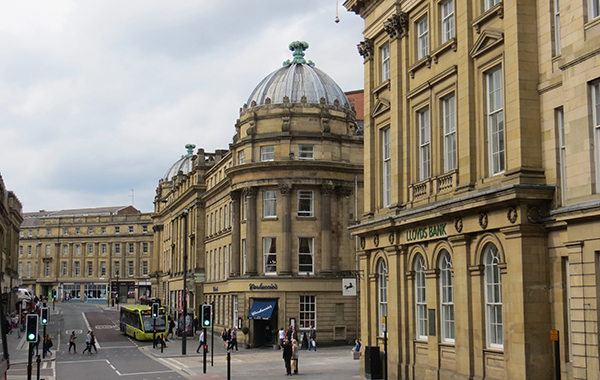Robert Merry heads North from his home in London to revisit a city he has not seen since he was boy. He revels in Northern sandstone, architecture, history and art.
Away the lad.
Someone bought me a weekend in Newcastle, as a present. Not for me to go on my own. They came with me.
It’s a city I had read much about but not visited since I was a child.
In fact, the man who ran the largest department store in Newcastle in those days was my God Father. Who knew!?
Newcastle’s Georgian city centre is the home of sandstone. The Tyne, the home of bridges. Such splendid bridges – The Tyne, Queen Elizabeth II, Edward VII, Swing, High Level, Gateshead Millennium and Redheugh. Victorian mostly, built for railwaymen and their ambitions, with walkways and double decks and cast iron girders and span.
It is a city built on the riches of coal and shipping.
And then there’s those sandstone buildings in Grey Street and Grainger Street and around. It is known as Grainger Town, after Richard Grainger the architect who drew up plans for the transformation of the centre of Newcastle in 1834.
The columns and pediment in front of the Royal Theatre are glorious, chunky, carved sandstone, wearing remarkably well for nearly 200 years of standing in the cooler climes of the North-East.
Some of the stone, around the back streets where no one sees it much, is black with pollution.
But it is a fine city centre. Grainger Market and Central Arcade, with its decorative faience tiles still pristine, as if they were fitted yesterday.
Often described as the finest street in Europe, Grey Street is the jewel in the crown, relatively untroubled by corporate giants, with sandstone façades intact.
Even older church steeples spike the skyline. Inside the Cathedral of St Nicholas, dating from 1091, are fine stained glass windows commemorating the fallen in the South Africa Boar War, and the 1914-18 and 1939-45 World Wars. 20th century stained glass windows, with minimalist, abstract images commemorate industrial pioneers of the city. And all set in sandstone window jambs and cills.
A fine alter rail in an orange/red marble I couldn’t identify. Black and white stone floors, probably Carrara and Belgian black.
And Portland stone. Portland! This far north? It makes an appearance as cladding on the outside of the city’s 1960s civic centre. There is green slate decorative cladding below windows and granite paving and plinths. Arabescato can be seen through the windows, decorating steps and tables. And thin delicate strips of Portland adorn the facade of the circular building on legs at the back, next to the wonderful David Wynne bronze statue of the Tyne River God cascading as a fountain down the civic centre walls.
And the Wren stone, a 500-year-old piece of history set in the wall in the inner space, flanked on four sides by the civic centre buildings.
The story goes that the council decided the city needed to look further than the local sandstone, to reflect a modern, forward-looking Newcastle.
The supplier, Portland Stone Firms, was so pleased with the order that it gifted to the city an original Wren sample stone from St Pauls Cathedral that had been left on the Dorset island that gives its name to the stone.
The council mounted the relic in the walls and carved an explanation of its origin into the new Portland stone around it.
A granite clad plinth by a small pond on the north side commemorates a visit by USA President Jimmy Carter.
At first glance it looks like what it is, I suppose: a rather dated municipal building.
But on closer inspection it is a place of beauty.
The fine sculpture of swans in flight, also by David Wynne, and the bronze seahorses by John Robert Murray McCheyne are more gems.
The building and surrounding streets were empty early on a Saturday morning, leaving us free to wander and stare.
The emptiness was eerie; the stone and sculpture a delight.
Newcastle’s coal and shipping industries are long gone.
Some boat building and ship repair yards still exist further up the river, near Tynemouth, but no more are the heady days of Swan Hunter and the Ark Royal.
We took the metro to Tynemouth Priory and Castle, standing on the top of the cliff above the sea. From there we strolled down through the North Shields quays, past the Corten steel sculpture of a Fiddlers Green Fisherman by Ray Longsdale.
Fiddlers Green is a place in the afterlife for fishermen and sailors lost at sea.
We caught the ferry to South Shields and were interrupted by tug boats pulling and pushing a cruise liner up the Tyne – for repair, I suppose. It was so big it almost blocked out the sun as it passed.
And then back on the Metro to Newcastle Central station, with its sandstone façade and splendidly curved, wrought iron-ribbed arched roof.
I haven’t mentioned The Cluney, The Sage, The Laing or the Baltic Flour Mill (now a contemporary art centre). But there’s simply not enough room for it all here.
A great trip to a great city. Ah yes, it were aareet!


